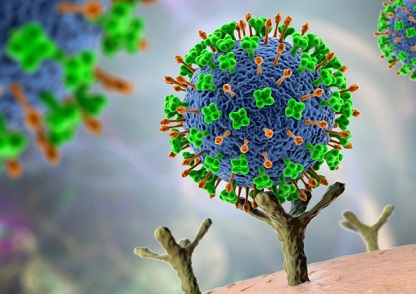SARS-CoV-2 Causes ACE2 Downregulation and Unique Fibrosis That Contribute to Long COVID-19
Nikhil Prasad Fact checked by:Thailand Medical News Team Jun 28, 2024 9 months, 2 weeks, 5 days, 14 hours, 16 minutes ago
COVID-19 News: Understanding Long COVID-19: A Growing Concern
The COVID-19 pandemic, caused by the SARS-CoV-2 virus, has dramatically impacted lives worldwide. While many people recover within weeks, some continue to experience symptoms long after the initial infection. This prolonged condition, known as Long COVID-19, is raising concerns among scientists and medical professionals. Recent studies by scientists from the University of Nicosia-Cyprus that is covered in this
COVID-19 News report, have revealed that the virus causes unique changes in the body, specifically related to ACE2 downregulation and fibrosis, which contribute to these lingering effects.
 SARS-CoV-2 Causes ACE2 Downregulation and Unique Fibrosis That
SARS-CoV-2 Causes ACE2 Downregulation and Unique Fibrosis That
Contribute to Long COVID-19
What is ACE2 and Why is it Important?
ACE2, or angiotensin-converting enzyme 2, is a protein found on the surface of various cells in our bodies, including those in the lungs, heart, kidneys, and intestines. It plays a crucial role in regulating blood pressure, healing tissues, and balancing fluids. Importantly, ACE2 acts as the entry point for the SARS-CoV-2 virus, allowing it to infect cells.
How SARS-CoV-2 Interacts with ACE2
When SARS-CoV-2 enters the body, it binds to the ACE2 protein on the surface of cells. This binding is the first step in the virus’s ability to infect and replicate within the host. However, this interaction doesn't just facilitate entry; it also leads to a significant reduction in ACE2 levels. This phenomenon, known as ACE2 downregulation, has far-reaching consequences for the body’s ability to function normally.
The Role of ACE2 Downregulation in Long COVID-19
ACE2 downregulation can disrupt several bodily functions, contributing to the prolonged symptoms observed in Long COVID-19 patients. Lower levels of ACE2 can lead to:
-Impaired Blood Pressure Regulation: ACE2 helps balance blood pressure. Its reduction can cause hypertension or low blood pressure, both of which can have serious health implications.
-Reduced Tissue Repair: ACE2 is involved in healing and regenerating tissues. Its downregulation can slow recovery from the damage caused by the virus, leading to persistent symptoms.
-Inflammation and Immune Response: ACE2 plays a part in controlling inflammation. Lower levels can result in an exaggerated immune response, causing chronic inflammation and contributing to the prolonged symptoms of Long COVID-19.
What is Fibrosis and How Does it Affect Long COVID-19?
Fibrosis is the formation of excess fibrous connective tissue in an organ or tissue, typically as a reparative or reactive process. It is essentially scarring that occurs when the body’s healing process goes awry. In the context of COVID-19, fibrosis can develop in the lungs, heart, and other organs, leading to significant a
nd often permanent damage.
Unique Fibrosis in COVID-19 Patients
Studies have shown that SARS-CoV-2 can cause a unique form of fibrosis that is different from other types. This fibrosis is characterized by:
-Lung Damage: The virus can cause severe lung damage, leading to the development of fibrous tissue in the lungs. This scarring can result in reduced lung capacity, making it difficult for patients to breathe and leading to long-term respiratory problems.
-Heart Complications: Fibrosis in the heart can affect its ability to pump blood efficiently, leading to conditions such as heart failure or arrhythmias.
Other Organs: Fibrosis can also affect other organs, including the kidneys and liver, further complicating the recovery process and contributing to the chronic symptoms of Long COVID-19.
Why Some People Develop Long COVID-19
Not everyone who contracts COVID-19 will develop Long COVID-19, and the reasons for this variation are still being studied. Factors that might contribute to the risk of developing Long COVID-19 include:
-Severity of Initial Infection: Those who experienced severe symptoms or required hospitalization are more likely to develop Long COVID-19.
-Pre-existing Health Conditions: Individuals with underlying health issues, such as diabetes or heart disease, may be at higher risk.
-Immune System Response: Variations in immune system responses might influence how the body deals with the virus and recovers from the infection.
Ongoing Research and Hope for the Future
Researchers around the world are working tirelessly to understand the mechanisms behind Long COVID-19 and find effective treatments. By studying the role of ACE2 downregulation and unique fibrosis, scientists hope to develop therapies that can prevent or reverse these changes, providing relief to those suffering from prolonged symptoms.
Conclusion
Long COVID-19 remains a significant challenge, affecting millions of people globally. The downregulation of ACE2 and the development of unique fibrosis are crucial factors contributing to this condition. As research continues, there is hope that new treatments will emerge, helping patients recover fully and reclaim their lives from the persistent grip of Long COVID-19.
Understanding these complex processes is essential for developing effective strategies to combat Long COVID-19 and support the health and well-being of affected individuals.
The study findings were published in the peer reviewed journal: Infectious Disease Report.
https://www.mdpi.com/2036-7449/16/4/42
For the latest
COVID-19 News, keep on logging to Thailand Medical News.
Read Also:
https://www.thailandmedical.news/news/vitamin-e-can-help-with-lung-fibrosis
https://www.thailandmedical.news/news/breaking-doctor-from-uc-san-diego-warns-of-new-covid-19-manifestations-such-as-dermatomyositis-muscular-pains-and-alerts-about-lung-fibrosis
https://www.thailandmedical.news/news/breaking-covid-19-news-44-9-percent-of-post-covid-individuals-develop-lung-fibrosis-irrespective-of-asymptomatic-or-mild-infections-jn-1-is-worse
